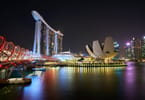KABUL – Sitting on the bank of Qarga Lake west of Kabul and playing with his kids, Ahmad Rashid said it almost becomes a routine for him to go out for excursion along with his family every week-end.
“I come here to enjoy nature and forget about the bitter past when factional fighting and the obstructionist policies of fundamentalist Taliban had forced millions of Afghans to leave the country,” the 24-year-old Rashid said while recalling past ordeals.
Rashid is not the only Afghan frequenting the Qarga Lake every Friday (weekly Muslim close-day in Afghanistan and many other Islamic countries).
There were others as well – some boating around the artificial lake while others, including couples and families, walking along the grassy banks of the lake, which is among the few recreational places in the war-battered Afghan capital.
Qarga Lake, located in a comparatively peaceful neighborhood, is almost the only picnic spot in the Afghan capital, where the war-weary Afghans take refuge every weekend.
The venue used to be jam-packed on weekends and other closed holidays.
Although in the pre-war times Afghanistan had been one of the few international tourist destinations in South and Central Asia, the decades of militancy and civil war has virtually pushed the country back into a conservative social order.
However, despite the security problems and the spiraling militancy, the post-Taliban Afghanistan has taken big strides in several socio-economic fields, including communication and hotel industry.
While tourism industry is yet at its toddling stage, the loving and hardworking people of Afghanistan are doing overtime to promote the industry.
Salang, a scenic valley 80-kilometer north of Kabul, is an old tourist destination which is replete with visitors every Friday.
The beautiful landscape of Salang, orchestrated with lush green orchards, fascinating river, streams and snow-clad mountain peaks, has now been frequented by Afghans and foreign visitors over the past seven years.
However, lack of modern tourist facilities, like skiing, chairlift, cable car, national park, does exist as hotels to house visitors are pitiable.
“The government is working on a plan to revive tourism industry,” Syed Zamanudin Baha, Director Tourism Department, Afghanistan said.
“Efforts are afoot to revitalize the industry. In this regard, rebuilding process of old castles and historic places, and preserving archeological sites have started,” Baha told Xinhua.
The government, he added, contemplated to set up national parks, hotels, and all facilities necessary to boost tourism industry in the country.
To develop the tourism, the government recently declared Band-e-Amir, a natural lake in the central Bamyan province, as a national park.
“Reconstruction of the giant Buddha statues in Bamyan is also on the agenda of the government to attract more tourists into the country,” Baha further disclosed.
The historic relic had been dynamited by the Taliban during their fanatic regime in March 2001.
Like other national institutions, the three decades of war and civil strife had also eroded the tourism industry in Afghanistan.
The chief of Tourism Department disclosed that the government, with the support and involvement of private sector, has built more than 80 hotels and guest houses across the country to facilitate tourists.
Last year, the government had issued visas to some 10,000 foreign tourists, Baha added.
He did not have the exact figure regarding annual income from tourism industry but said that millions of Afghanis (one U.S. dollar is equal to 50 Afghanis) would be earned every year.
Afghanistan is the cradle of old civilizations dated back to the Zoroastrian era, the Greek-Bactrian times, and Alexander the Great’s period.
Archeological sites, like the huge castle in Balkh province, Takht-e-Rustam (Rustam’s Throne) in Samangan province, Shahr-e-Ghulghula (Scream city) in Bamyan province, Munar-e-Jam (Jam Minarets), and many other relics are living monuments of all these civilizations.
Tora Bora, the former hideout of al-Qaeda chief Osama Bin Ladenin east Afghanistan ahead of U.S.-led military campaign against Taliban which led to the collapse of Taliban regime in 2001, is most likely to be made into another tourist destination, Baha said.
The caves in Tora Bora had offered adventurist puzzle. “Under the seven-year plan, the government plans to renovate and preserve archeological sites and create national parks to boost tourism industry as tourists are the messengers of peace, promoters of cultures and civilizations,” the Director of Tourism Department asserted.
WHAT TO TAKE AWAY FROM THIS ARTICLE:
- Although in the pre-war times Afghanistan had been one of the few international tourist destinations in South and Central Asia, the decades of militancy and civil war has virtually pushed the country back into a conservative social order.
- “Reconstruction of the giant Buddha statues in Bamyan is also on the agenda of the government to attract more tourists into the country,”.
- To develop the tourism, the government recently declared Band-e-Amir, a natural lake in the central Bamyan province, as a national park.






















